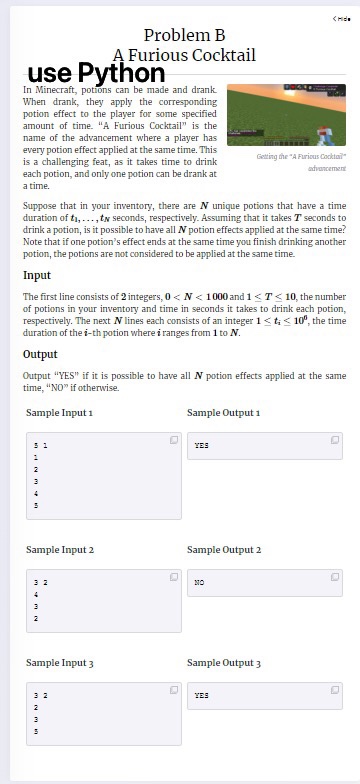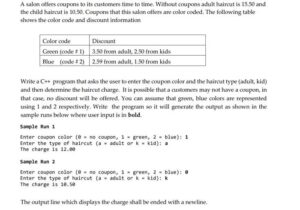Can someone please answer the coding question below in C++ and leave comments explaining the code throughout. There is a tree (i.e., a connected, undirected graph that has no cycles) consisting of n nodes numbered from 0 to n – 1 and exactly n – 1 edges. Each node has a value associated with it, and the root of the tree is node 0.To represent this tree, you are given an integer array nums and a 2D array edges. Each nums[i] represents the ith node’s value, and each edges[j] = [uj, vj] represents an edge between nodes uj and vj in the tree.Two values x and y are coprime if gcd(x, y) == 1 where gcd(x, y) is the greatest common divisor of x and y.An ancestor of a node i is any other node on the shortest path from node i to the root. A node is not considered an ancestor of itself.Return an array ans of size n, where ans[i] is the closest ancestor to node i such that nums[i] and nums[ans[i]] are coprime, or -1 if there is no such ancestor. Example 1:Input: nums = [2,3,3,2], edges = [[0,1],[1,2],[1,3]] Output: [-1,0,0,1] Explanation: In the above figure, each node’s value is in parentheses. – Node 0 has no coprime ancestors. – Node 1 has only one ancestor, node 0. Their values are coprime (gcd(2,3) == 1). – Node 2 has two ancestors, nodes 1 and 0. Node 1’s value is not coprime (gcd(3,3) == 3), but node 0’s value is (gcd(2,3) == 1), so node 0 is the closest valid ancestor. – Node 3 has two ancestors, nodes 1 and 0. It is coprime with node 1 (gcd(3,2) == 1), so node 1 is its closest valid ancestor.Example 2:Input: nums = [5,6,10,2,3,6,15], edges = [[0,1],[0,2],[1,3],[1,4],[2,5],[2,6]] Output: [-1,0,-1,0,0,0,-1] Constraints:nums.length == n1 <= nums[i] <= 501 <= n <= 105edges.length == n – 1edges[j].length == 20 <= uj, vj < nuj != vjHere is starting class: class Solution {public:vector getCoprimes(vector& nums, vector<vector>& edges) { }};
![The University of Western Ontario Department of Computer Science London, Canada Software Tools and Systems Programming (Computer Science 2211A) LAB7 The week of October 22 - October 28, 2023 This lab is an exercise with pointer arithmetic. Question 2 of the lab exercise is taken from exercise 17 in Chapter 12 of our textbook: C Programming Language: A Modern Approach (Second Edition), by K. N. King. 1. Rewrite the following function to use pointer arithmetic instead of array subscripting. (In other words, eliminate the variables i and all of the [] operators.) Note that for any array a, the expression a[i] is equivalent to *(a+i). int sum_array(const int a[], int n) { int i, sum = 0; for (i = 0; i < n; i++) sum += a[i]; return sum; }](https://gotit-pro.com/wp-content/uploads/2023/10/c80fe157-523d-4b22-a16d-64c419fa011c-300x273.png) THE UNIVERSITY OF WESTERN ONTARIO DEPARTMENT OF COMPUTER SCIENCE LONDON CANADA Software Tools and
Original price was: $10.00.$5.00Current price is: $5.00.
THE UNIVERSITY OF WESTERN ONTARIO DEPARTMENT OF COMPUTER SCIENCE LONDON CANADA Software Tools and
Original price was: $10.00.$5.00Current price is: $5.00.
 1 Create a TypeScript program that repeats the values 1 to 100 with the following loop operation
Original price was: $10.00.$5.00Current price is: $5.00.
1 Create a TypeScript program that repeats the values 1 to 100 with the following loop operation
Original price was: $10.00.$5.00Current price is: $5.00.
Can someone please answer the coding question below in C and leave comments explaining the code
Original price was: $10.00.$5.00Current price is: $5.00.
-50%Download button will appear immediately after successful payment.
Full support will be provided with necessary files installation.
Get impeccable customized solution within 24 hours, hassle-free.

 25% off with code “SUMMER”
25% off with code “SUMMER”






![Your task is to implement in Python the following adversarial search algorithms (refer to lecture slides and/or your textbook for details | pseudocode provided below): MiniMax (as specified by the MINIMAX-SEARCH pseudocode below) When the game is complete, your program should display a corresponding message: X WON or O WON TIE X LOST or O LOST MiniMax with alpha-beta pruning (as specified by the ALPHA-BETA-SEARCH pseudocode below), and apply them to play the game of Tic-Tac-Toe (computer). Using any other approach is not going to be accepted. Problem input/command line interface: Your program should: Accept three (3) command line arguments, so your code could be executed with python cs480_P01_AXXXXXXXX.py ALGO FIRST MODE where: - cs480_P01_AXXXXXXXX.py is your python code file name, - ALGO specifies which algorithm the computer player will use: 1 - MiniMax, 2 - MiniMax with alpha-beta pruning, - FIRST specifies who begins the game: X When it is human player's turn, your program should display the following prompt: X's move. What is your move (possible moves at the moment are: | enter 0 to exit the game)? where: is a sorted list of all available moves at the moment, for example, if the board arrangement is: and it is X's move, the prompt should be: What is your move (possible moves at the moment are: 2, 3, 7, 9) | enter 0 to exit the game)? If the user enters anything other than 0/ valid move number (0 should terminate the game) your program should repeat the prompt above. Once the user enters a valid move, display the updated game board on screen. When it is the computer's turn (regardless of the game mode), your program should display (it could be an 'X' or 'O' move): X's selected move: Z. Number of search tree nodes generated: A.A.A where: - Z is the move/action number (a positive integer from the {1, 2, 3, 4, 5, 6, 7, 8, 9} set) selected by computer - A.A.A is the number of search tree nodes generated (the number of MiniMax nodes computer explored before making the decision [including "root"]) to select it. Follow it with the updated game board on screen. - NOTE!!! Computer's search tree move exploration order should be in a sorted fashion (1, 2, 3, 4, 5, 6, 7, 8, 9 | assuming HERE that ALL moves are available). 2 - computer (X) versus computer (O), Example: python cs480_P01_A11111111.py 2 X 1 If the number of arguments provided is NOT three (none, one, two or more than three) or arguments are invalid (incorrect ALGO, FIRST or MODE) your program should display the following error message: ERROR: Not enough/too many/illegal input arguments. and exit. Program details: Specific program details: The Tic-Tac-Toe game board is represented by 3x3 grid with cells numbered as follows - Possible moves/actions for both players match cell numbers (if a player wants to place an 'X' in the middle of the board, the move/action is '5'), Your program should begin by displaying the following information: Last Name, First Name, Axxxxxxxx solution: Algorithm: MiniMax with alpha-beta pruning First: X Mode: human versus computer where: - Axxxxxxxx is your IIT A number, - Algorithm is the algorithm specified by a command line argument, - First is the information who makes the first move as specified by a command line argument, - Mode is the game mode as specified by a command line argument, If the game mode is human versus computer display an empty board first and prompt the user to pick the move (see below)](https://gotit-pro.com/wp-content/uploads/2023/10/9a1b7061-c5a7-48b6-a744-6dc4634c6532-300x277.png)
Erica Cupp –
Excellent job, my friend. Thank You!!
Nancy Del –
Follows the required notes. Right on time. Amazing solution.
Chris Brooks –
I am glad I got assistance, I’m am very happy with the service.
Frank Cory –
Thanks a lots, I really appreciate your effort it is an excellent report.
Megan Mowles –
Thank for your help and service. I really like the work that they did on my paper.